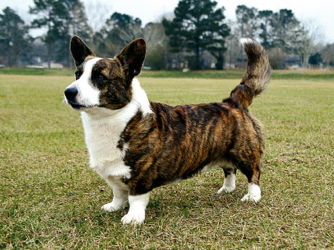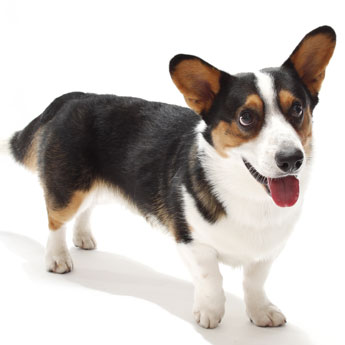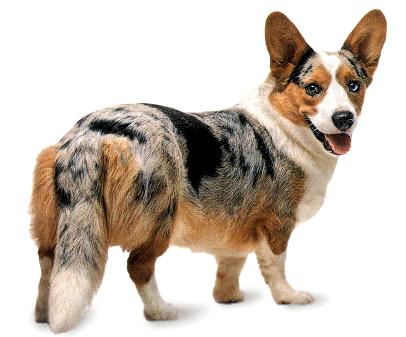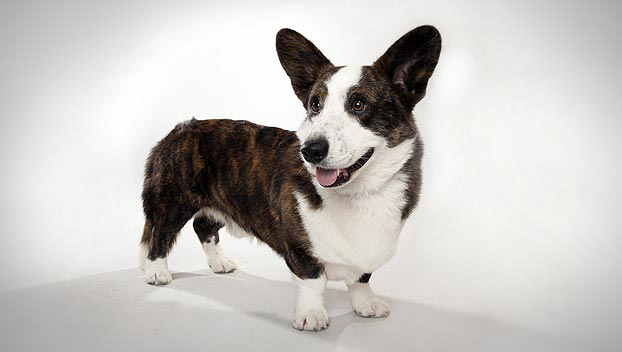
The Breed History
In early history, and arising from the same type of dog that gave
rise to the Dachshund, the progenitors of the modern day Cardigan
Welsh Corgi were brought to Cardiganshire in Wales around 1200
BC. Other bloodlines that may have contributed to the corgi type
include Shipperke, Swedish Valhunds, and Finnish Spitz dogs.
Breeders split the breed into Cardigan and Pembroke Corgis around
1934. In 1931, Cardis were first brought to the US, and the AKC
registered them in 1935. The name Corgi is thought to be a Celtic
word for dog or perhaps a Welsh word for dwarf dog.
Breeding for Function
These dogs were valued as guarding dogs, and were used to
manage cattle by driving and dispersing them on the common
pastures. They were also valued as a vermin hunter. They perform
well in agility and herding competitions, and have become a
popular companion pet.
Physical Characteristics
Height at Withers: female 10.5-12.5 " (26.5-31.5 cm), male
10.5-12.5 " (26.5-31.5 cm).
Weight: females 25-34 lb (11.5-15.5 kg), males 30-38 lb (13.5-17 kg).
Coat: The double coat of medium length should never be primarily
white. Blue merle may have pigmented points, and black, red, sable,
and brindle coats may have white on chest, legs, neck, face (except
around eyes), and tail tip. A tri-color coat is also sometimes seen.
They are not clipped for show.
Longevity: 12-15 years.
Points of Conformation: These sturdy, low-set muscular dogs
with great agility and intelligence have a very alert expression.
Their forefeet normally are displaced laterally and legs bowed
due to chondrodystrophic conformation. Their eyes have dark
pigmentation at the palpebral margin and the eyes are dark except
in the blue merles, where blue eyes are acceptable. The face has a
moderate stop, and the muzzle is tapered. Moderate length of neck,
and well-sprung ribs with moderate tuck up in loins are evident.
The long back has only a slight slope down towards the tail base
along the topline. The tail is long and thick and rear dewclaws are
generally removed. The Pembroke is shorter, has straighter legs,
ears are smaller and more pointed, and the tail is docked short in
comparison.
Recognized Behavior Issues and Traits
Reported breed characteristics include: Loyal, protective intelligent
dog, they learn quickly, and are active dogs. They are wary of
strangers, and are an excellent alarm barker. Early training and
socialization to people and other pets are important for these dogs.
They may try to herd children by nipping at the heels, but can
be trained away from this behavior. If left alone for long periods,
these dogs tend to chew or bark. They benefit from daily moderate
exercise, and are generally calmer than Pembrokes. They are high
shedders, but require low to moderate grooming.
Normal Physiologic Variations
None reported
Drug Sensitivities
None reported
Inherited Diseases
Hip Dysplasia: Polygenically inherited trait causing degenerative
joint disease and hip arthritis. OFA reports 19.1% affected.
Patella Luxation: Polygenically inherited laxity of patellar
ligaments, causing luxation, lameness, and later degenerative joint
disease. Treat surgically if causing clinical signs. Reported at a high
rate, but too few Cardigan Welsh Corgis have been screened by OFA
to determine an accurate frequency.
Elbow Dysplasia: Polygenically inherited trait causing elbow
arthritis. OFA reports 3.2% affected.
Progressive Retinal Atrophy (PRA): Autosomal recessive rcd3
form of PRA occurs in the breed. Begins with night blindness by 6
months of age, and total blindness by 2-3 years. A genetic test is
available, showing 8.5% testing carrier. CERF does not recommend
breeding affected dogs.
Disease Predispositions
Hypothyroidism: Inherited autoimmune thyroiditis. 5.5% positive
for thyroid auto-antibodies based on testing at Michigan State
University. (Ave. for all breeds is 7.5%).
Persistent Pupillary Membranes: Strands of fetal remnant
connecting; iris to iris, cornea, lens, or involving sheets of tissue. The
later three forms can impair vision, and dogs affected with these
forms should not be bred. Identified in 4.71% of Cardigan Welsh
Corgis CERF examined by veterinary ophthalmologists between
2000-2007.
Distichiasis: Abnormally placed eyelashes that irritate the cornea
and conjunctiva. Can cause secondary corneal ulceration. Identified
in 4.20% of Cardigan Welsh Corgis CERF examined by veterinary
ophthalmologists between 2000-2005.
Cataracts: Anterior cortex punctate cataracts predominate in
the breed. Age of onset 3 years. Reported in 2.53% of Cardigan
Welsh Corgis presented to veterinary teaching hospitals. Identified
in 1.91% of Cardigan Welsh Corgis CERF examined by veterinary
ophthalmologists between 2000-2005. CERF does not recommend
breeding any Cardigan Welsh Corgi with a cataract.
Degenerative Myelopathy (DM): Affected dogs show an insidious
onset of upper motor neuron (UMN) paraparesis at an average
age of 11.4 years. The disease eventually progresses to severe
tetraparesis. Affected dogs have normal results on myelography,
MRI, and CSF analysis. Necropsy confirms the condition. Reported
at a frequency of 1.51% in Cardigan Welsh Corgis. Unknown mode
of inheritance. A direct genetic test for an autosomal recessive DM
susceptibility gene is available. All affected dogs are homozygous
for the gene, however, only a small percentage of homozygous dogs
develop DM. OFA testing reports 39% carrier and 10% homozygous
"at risk" for DM.
Retinal Dysplasia: Focal folds and geographic retinal dysplasia are
seen in the breed. It is questionable whether focal folds can lead
to disease, however dogs with the geographic form should not be
bred. Reported in 0.76% of Cardigan Welsh Corgis CERF examined
by veterinary ophthalmologists between 2000-2005.
Cystinuria/Cystine Bladder Stones: Caused by a metabolic
abnormality in cystine metabolism. Welsh Corgis have an
increased risk for developing cystine bladder stones. Treat with
surgical removal and life-long medical therapy. Unknown mode of
inheritance in this breed. Dorn reports a 4.14x increased odds ratio
for bladder stones versus other breeds.
Perineal Hernia: An Australian study identified the Corgi breed as
most commonly affected with perineal hernias. The mean age of
affected dogs was 9.4 years. Treatment is herniorrhaphy surgery.
Glaucoma: Primary, narrow angle glaucoma occurs in the breed.
Can cause blindness due to retinal damage, or secondary lens
luxation. Screen with gonioscopy and tonometry. Frequency and
mode of inheritance in the breed has not been determined.
Intervertebral Disc Disease (IVDD): Serious neurological condition
where disk degeneration and rupture into spinal nerves and the
spinal cord causes pain and possible paralysis. Requires immediate
veterinary care. Dorn reports a 1.70x increased odds ratio versus
other breeds.
Central progressive Retinal Atrophy, Ceroid Lipofuscinosis, and
Methemaglobin Reductase Deficiency are reported.
Isolated Case Studies
X-linked Severe Combined Immunodeficiency (XSCID): X-linked
recessive disorder was identified in one family of Cardigan Welsh
Corgis. Affected dogs cannot generate antigen-specific immune
responses. A genetic test was developed to identify carrier females.
Mucopolysaccharidosis VI (MPS VI): PennGen reports MPS VI
identified in the Welsh Corgi. This is an autosomal recessive disorder
causing skeletal deformities, including defects in the sternum,
vertebrae and particularly the hip joints. To varying degrees they
may also experience corneal cloudiness and facial dysmorphia. A
genetic test is available.
Genetic Tests
Tests of Genotype: Direct test for rcd3 form of PRA is available
from Optigen, Healthgene, VetGen, and the Peterson-Jones Lab.
at Michigan State University: http://www.cardigancorgis.com/
PRAPressRelease.aspx (517-353-3278)
Direct coat color tests for presence of black, "clear red", chocolate and
sable colors, and mask are available from HealthGene and VetGen.
Direct genetic test for an autosomal recessive DM susceptibility
gene is available from the OFA.
Direct tests for SCID is available from PennGen.
Phenotypic test for MPS VI is available from PennGen.
Tests of Phenotype: CHIC Certification: Required tests are; CERF
eye examination, genetic test for rcd3-PRA, and hip radiographs.
(See CHIC website: www.caninehealthinfo.org)
Recommend patella evaluation, elbow radiographs, thyroid profile
including autoantibodies, and cardiac evaluation.
Miscellaneous
- Breed name synonyms: Cardigan, Corgi, Cardi
- Registries: AKC, UKC, CKC , KCGB (Kennel Club of Great Britain),
ANKC (Australian National Kennel Club), NKC (National Kennel Club)
- AKC rank (year 2008): 82 (845 dogs registered)
- Internet resources: Cardigan Welsh Corgi Club of America:
www.cardigancorgis.com
Cardigan Welsh Corgi Association (UK):
www.cardiganwelshcorgiassoc.co.uk
Canadian Cardigan Corgi Club: www.cardigancorgi.ca
Photo Gallery of Breed - Cardigan Welsh Corgi - Dog Breed








 Animalia Life
Animalia Life